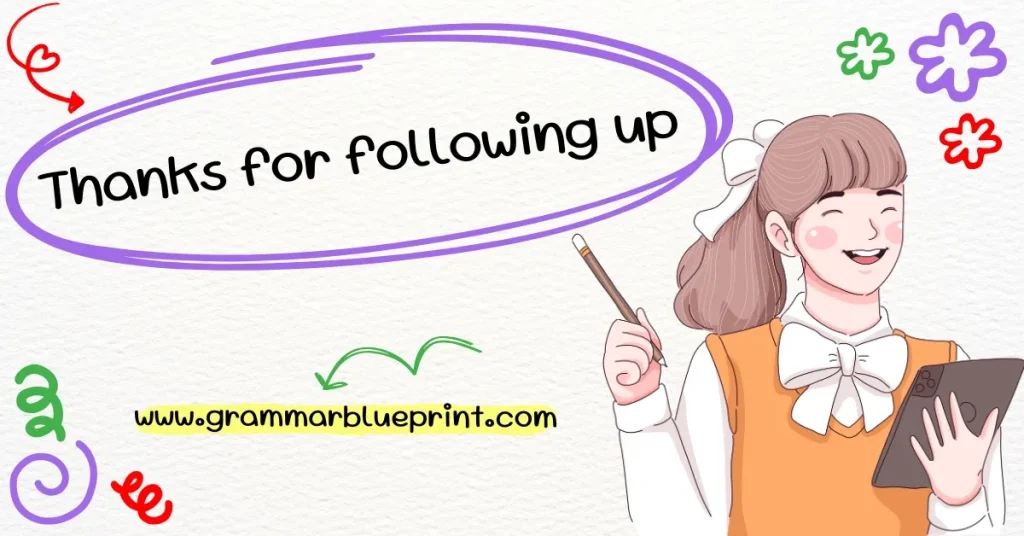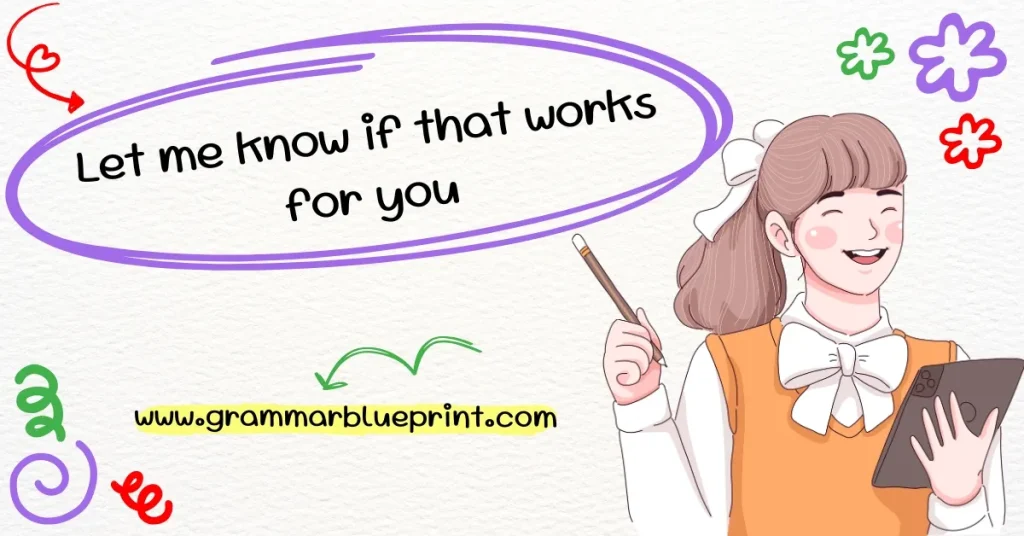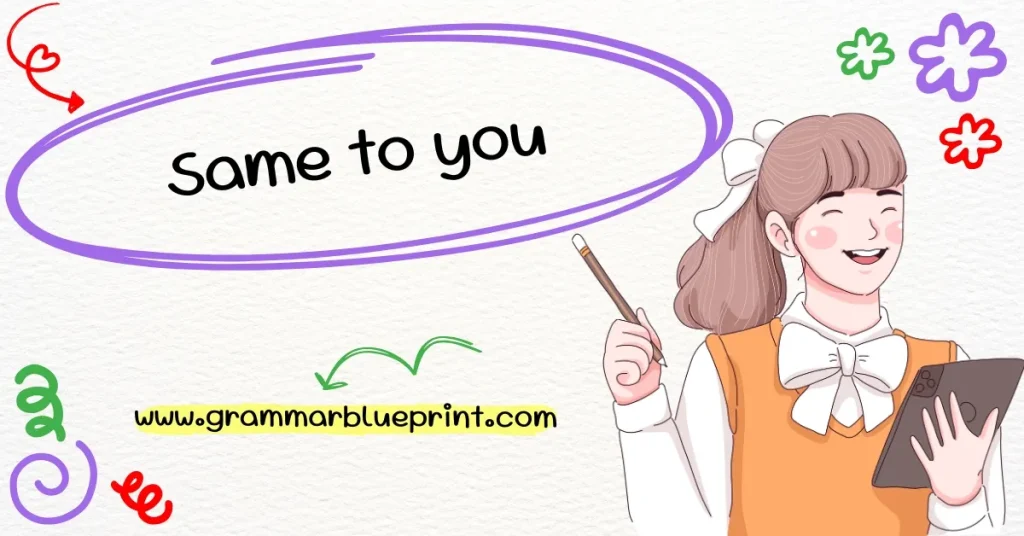In today’s fast-paced professional world, keeping communication clear and courteous is key to building strong relationships. The phrase “Thanks for following up” is a simple yet effective way to acknowledge someone’s effort in continuing a conversation. Whether in emails or meetings, it can strengthen your professional ties and show appreciation for others’ attention to detail.
What is “Thanks for Following Up”?
“Thanks for following up” is a polite and professional phrase often used to acknowledge someone’s persistence in continuing a conversation or addressing a matter that might have been overlooked or delayed. It expresses gratitude for the sender’s follow-up message, showing that you value their efforts in staying on top of communication.
In professional settings, follow-ups are important to ensure that tasks are completed, decisions are made, or information is provided. Acknowledging a follow-up email with a phrase like “Thanks for following up” demonstrates respect for the sender’s time and initiative, maintaining a courteous and open communication channel.
Why Use “Thanks for Following Up”?
When you receive a follow-up message, using the phrase “Thanks for following up” can significantly enhance communication. It’s a simple way to acknowledge someone’s effort, showing that you appreciate their persistence and attention to detail. This can be especially important in professional settings where timely communication is essential for smooth operations.
By acknowledging follow-ups, you maintain a positive rapport with colleagues, clients, or customers. It reflects professionalism and encourages ongoing communication. It’s not just about politeness—it’s about fostering a collaborative environment where both parties feel heard and valued.
When to Use “Thanks for Following Up”
The phrase “Thanks for following up” can be used in a variety of situations, including:
- Job Applications: When a candidate follows up after an interview or application submission.
- Sales and Marketing: When a potential client follows up on a proposal or inquiry.
- Customer Service: When a customer checks in on an issue, delivery, or request.
- Internal Communication: When colleagues follow up on pending projects or tasks.
In all these situations, using this phrase helps keep the communication open and professional, acknowledging the effort of the other party without sounding overly formal or dismissive.
How to Respond to Follow-Up Emails Professionally
Responding to follow-up emails professionally is essential for maintaining strong business relationships. Here’s a step-by-step guide to crafting an effective reply:
- Acknowledge the Follow-Up: Begin by thanking the person for their follow-up. This shows appreciation for their persistence.
- Example: “Thank you for following up on this.”
- Example: “Thank you for following up on this.”
- Provide the Necessary Information or Response: Address the inquiry or concern that the person has followed up on. Be clear and concise.
- Example: “Regarding your request, I’ve attached the document you asked for.”
- Example: “Regarding your request, I’ve attached the document you asked for.”
- Be Timely: Ensure your response is sent within a reasonable time frame. Delays in responding can be frustrating for the person who followed up.
- End on a Positive Note: Close the email by inviting further communication or offering assistance.
- Example: “Feel free to reach out if you have any further questions.”
- Example: “Feel free to reach out if you have any further questions.”
Example Response 1: Job Inquiry
Subject: Follow-Up on Job Application
Dear [Name],
Thank you for following up on your job application. I appreciate your interest in the position and your patience during the review process. We are currently reviewing all applications, and we will be in touch with next steps soon. Thank you again for your persistence, and we look forward to speaking with you soon.
Best regards,
[Your Name]
Example Response 2: Customer Service Inquiry
Subject: Follow-Up on Your Support Request
Dear [Name],
Thanks for following up on your support ticket. We are currently reviewing your issue and will provide a solution shortly. We appreciate your patience and are doing everything we can to resolve this as soon as possible. Please don’t hesitate to reach out if you need anything else in the meantime.
Sincerely,
[Your Name]
Benefits of Using “Thanks for Following Up”
Using “Thanks for following up” brings several key benefits to professional communication:
- Strengthens Relationships: By acknowledging someone’s follow-up, you reinforce a positive working relationship. People appreciate when their efforts are recognized, even if it’s just a small gesture like thanking them for their persistence.
- Encourages Timely Communication: Acknowledging follow-ups encourages the sender to stay engaged in the conversation, promoting a cycle of timely communication.
- Prevents Misunderstandings: By clarifying the status of tasks or inquiries in your response, you help reduce potential misunderstandings or miscommunications, making your workflow smoother.
- Promotes a Collaborative Atmosphere: A simple thank you for a follow-up invites further discussion, ensuring that everyone stays on the same page, which is essential for teamwork.
Common Mistakes to Avoid When Saying “Thanks for Following Up”
While “Thanks for following up” is generally a positive expression, it can be misused in some situations:
- Overuse of the Phrase: Using “Thanks for following up” too frequently can make it seem insincere or mechanical. Make sure you’re genuinely appreciating the person’s effort and not just repeating the phrase as a formality.
- Using It in the Wrong Context: If the follow-up is unnecessary (e.g., someone repeatedly asks for an update you already provided), using this phrase can sound dismissive. In such cases, consider a more direct response that addresses the issue.
- Failure to Provide a Proper Response: Saying “Thanks for following up” without giving a clear answer or next step can lead to frustration. Always ensure that your follow-up message includes valuable information or a plan of action.
Example Mistake 1: Overuse
- Incorrect: “Thanks for following up, I appreciate it.”
- Better: “Thank you for following up. I’ve reviewed your request, and I’ll have an update for you by tomorrow.”
Example Mistake 2: Incorrect Context
- Incorrect: “Thanks for following up again. I told you last week about the delay.”
- Better: “Thank you for following up. I understand your concern, and I’m currently working on resolving the delay.”
Better Alternatives to Say “Thanks for Following Up”
While “Thanks for following up” is a useful phrase, there are many other alternatives that can convey the same gratitude but may suit different contexts or tones. Here are several alternatives:
1. I Appreciate Your Follow-Up
- Meaning: A formal way of thanking someone for their persistence.
- Best Use: Professional settings, especially when someone has been waiting for a response
- Tone: Polite and respectful.
2. Thank You for Reaching Out Again
- Meaning: Acknowledges the sender’s continued engagement.
- Best Use: When someone has contacted you multiple times about a matter.
- Tone: Friendly but formal.
3. I’m Grateful for Your Update
- Meaning: Acknowledges that the follow-up brought important new information.
- Best Use: When the follow-up provides critical updates or information.
- Tone: Appreciative and professional.
4. Thanks for Getting Back to Me
- Meaning: A casual but polite way to acknowledge a response.
- Best Use: More informal or friendly communication.
- Tone: Friendly and conversational.
5. I Appreciate You Checking In
- Meaning: Thanking someone for providing a check-in or reminder.
- Best Use: When someone follows up to keep the conversation going.
- Tone: Friendly and courteous.
6. Thank You for Your Persistence
- Meaning: Appreciates the effort someone has made in following up.
- Best Use: In situations where the sender has demonstrated a strong desire to move forward.
- Tone: Grateful and encouraging.
7. I’m Thankful for Your Continued Interest
- Meaning: Acknowledges ongoing interest in a matter.
- Best Use: In sales or job application contexts where the sender’s engagement is important.
- Tone: Respectful and appreciative.
8. Thanks for Keeping Me in the Loop
- Meaning: Acknowledges someone for staying on top of an ongoing conversation.
- Best Use: When someone continues to update you about an ongoing issue.
- Tone: Casual but polite.
9. Thank You for the Follow-Up Message
- Meaning: A simple acknowledgment that someone has sent a follow-up message.
- Best Use: When you want to acknowledge receipt of the message and show appreciation for the follow-up.
- Tone: Polite and straightforward.
10. I Appreciate Your Patience
- Meaning: Acknowledges the sender’s patience in waiting for a response.
- Best Use: When someone has been waiting for a while for an answer and follows up.
- Tone: Grateful and understanding.
11. Thanks for Staying in Touch
- Meaning: Acknowledges someone’s effort to keep communication going.
- Best Use: In scenarios where someone follows up with you on a regular basis.
- Tone: Friendly and appreciative.
12. I’m Grateful for Your Prompt Follow-Up
- Meaning: Expresses gratitude for a timely follow-up.
- Best Use: When the sender quickly responds or follows up on an earlier message.
- Tone: Professional and thankful.
13. Thank You for Following Through
- Meaning: Acknowledges the person for completing an action or task they said they would.
- Best Use: When someone follows through on their commitments or promises.
- Tone: Respectful and appreciative.
14. Thanks for Touching Base with Me Again
- Meaning: Acknowledges someone checking in or reconnecting.
- Best Use: When someone follows up to maintain communication or check in on an ongoing matter.
- Tone: Casual and friendly.
15. I Appreciate Your Dedication
- Meaning: Expresses appreciation for someone’s commitment or ongoing effort in communication.
- Best Use: When someone continues to reach out persistently about a subject.
- Tone: Positive and encouraging.
16. Thank You for Staying on Top of This
- Meaning: Acknowledges the person for being proactive in staying updated.
- Best Use: When someone regularly follows up or manages a situation effectively.
- Tone: Appreciative and respectful.
17. I Appreciate You Keeping Track
- Meaning: Recognizes someone for actively keeping track of details or progress in a situation.
- Best Use: In scenarios where someone is managing an ongoing project or issue.
- Tone: Professional and polite.
18. Thanks for Your Continued Communication
- Meaning: Thanks the person for maintaining regular communication.
- Best Use: When someone consistently keeps you updated or communicates regularly.
- Tone: Formal and grateful.
19. I’m Thankful for Your Consistent Follow-Up
- Meaning: Expresses gratitude for someone’s ongoing effort in following up.
- Best Use: When someone continues to check in on a matter.
- Tone: Appreciative and encouraging.
20. Thank You for Staying in Contact
- Meaning: Acknowledges someone for staying connected with you.
- Best Use: When someone maintains regular communication or updates.
- Tone: Professional yet warm.
21. Thanks for Your Timely Follow-Up
- Meaning: Acknowledges that the follow-up was done promptly.
- Best Use: When a follow-up comes at an appropriate and timely moment.
- Tone: Polite and professional.
22. I Appreciate Your Effort to Stay Connected
- Meaning: Thanks the person for making the effort to maintain communication.
- Best Use: When someone consistently reaches out to stay in touch or check on progress.
- Tone: Grateful and polite.
23. Thanks for Your Ongoing Attention
- Meaning: Recognizes that the person is continuously attentive to the matter.
- Best Use: When someone remains focused on an issue and continues to follow up.
- Tone: Formal and respectful.
24. I’m Grateful for Your Thoroughness
- Meaning: Acknowledges someone for being thorough in their follow-up.
- Best Use: When someone provides detailed or comprehensive updates in their follow-up.
- Tone: Professional and appreciative.
25. Thank You for Keeping Me Updated
- Meaning: Acknowledges someone’s effort in providing regular updates.
- Best Use: When someone regularly provides information or status updates on a matter.
- Tone: Professional and thankful.
26. Thanks for Your Continued Engagement
- Meaning: Expresses gratitude for someone’s ongoing involvement or communication.
- Best Use: When someone is actively engaged in a conversation or project.
- Tone: Formal yet appreciative.
27. I Appreciate You Keeping the Conversation Going
- Meaning: Thanks the person for continuing the conversation or discussion.
- Best Use: When someone regularly follows up or responds to keep the dialogue open.
- Tone: Friendly and appreciative.
28. Thank You for Checking in Once More
- Meaning: Acknowledges someone’s additional follow-up.
- Best Use: When someone follows up multiple times to ensure everything is on track.
- Tone: Polite and appreciative.
29. Thanks for Following Up Again
- Meaning: Thanks someone for their continued efforts to follow up.
- Best Use: When someone has followed up more than once on a matter.
- Tone: Friendly and courteous.
30. I Appreciate Your Follow-Up Efforts
- Meaning: Acknowledges the individual’s hard work in following up.
- Best Use: When you want to emphasize the person’s effort and persistence.
- Tone: Grateful and appreciative.
How to Keep Your Follow-Up Professional
To ensure your follow-up emails are effective and professional, consider the following tips:
- Be Clear and Direct: Ensure your subject line and message are specific and easy to understand. Avoid vague or overly complicated language.
- Maintain Professional Tone: Even in casual settings, keeping a respectful and professional tone is important. Avoid slang or overly informal language.
- Provide Necessary Details: Make sure the recipient has all the information they need to respond or take action.
- Be Timely: Follow up promptly after a reasonable waiting period to keep communication flowing.
Tips for Effective Follow-Up Communication
Effective follow-up communication is an essential skill in any professional setting. Here’s how to ensure your follow-ups are both respectful and efficient:
- Timeliness Matters: Don’t delay unnecessarily in responding to emails or messages. Follow up at appropriate intervals.
- Be Concise: Respect the recipient’s time by keeping your message short and to the point.
- Polite Persistence: While it’s important to follow up, don’t overwhelm the person with repeated emails or messages.



